Diseases and Pests of Peach Tree [Identify and Treat Them]
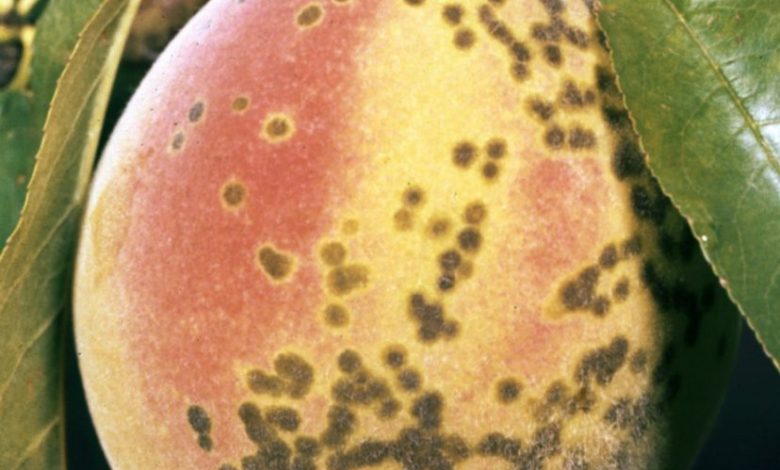
How beautiful are the fruits and how pleasant it is to harvest the harvest, but what happens when diseases or pests of the peach tree appear?
It is necessary to attack them immediately and it is for this reason that today we present a list with the most common diseases and pests of the peach tree.
Maybe you are also interested in:
- Plant a peach tree step by step.
- Peach tree pruning.
- How to fertilize a peach tree.
- Peach tree leprosy.
Diseases that attack the peach tree
powdery mildew
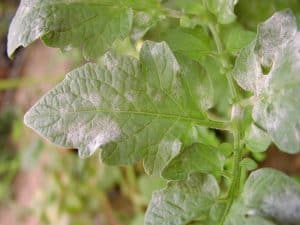 It is one of the most frequent affections of many plants, not only the peach tree.
It is one of the most frequent affections of many plants, not only the peach tree.
Its presence generates whitish colorations throughout the structure of the tree that end up affecting its strength and development capacity.
When the case is very advanced, the fruits will fall without completing their maturation process and impossible to consume.
It is important to note that the disease usually appears more on the sunniest days of summer.
Treatment for powdery mildew on peach trees
In these cases, it will be more preventive than corrective as far as possible.
This means that proper plant care will help prevent the fungus from attacking it.
Good measures include composting, pruning, and watering in the correct amounts.
It will also help to use products intended to prevent the appearance of fungi, such as fungicides. Like neem oil or potassium soap.
In these cases, it is good to select a product that is non-toxic and respectful of the environment.
dents
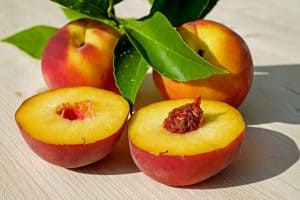 As its name indicates, this disease causes damage to the surface of the tree, generating deformations.
As its name indicates, this disease causes damage to the surface of the tree, generating deformations.
These deformations, in turn, cause a negative impact around the strength of the plant and make the structure fragile.
By the way, it is generated that the leaves fall and that the fruits (if any) are also born with deformations.
To recognize the disease, it will only be enough to detail the color of the deformations, since these appear in dark green mixed with white and also in red.
When the disease is not controlled in time, it can lead to the appearance of aphids.
In other cases it is also known as peach tree leprosy.
Treatment of dents in the peach tree
To deal with this disease, it is necessary to attack it early, that is, before the plant begins to flower.
If it is executed after this, the damage can go much deeper and become an irreversible matter.
In this case, the use of anti-pest products will be the ideal option, focusing on the work with dents in a timely manner.
It is also important to note that its proliferation is quite fast, especially on rainy days, and can cause a total loss of the crop.
Monilia
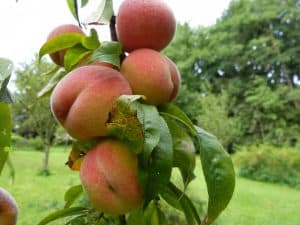 For any tree that bears fruit that includes a hard pit, such as the peach tree, Monilia is one of the most worrisome diseases.
For any tree that bears fruit that includes a hard pit, such as the peach tree, Monilia is one of the most worrisome diseases.
Its action occurs directly on the flowers and fruits, causing an obvious loss in the harvest.
However, the most complex thing about this situation is that it can also become visible after the harvest has been harvested. That is, when it leaves the sowing fields towards the spaces where it will be marketed.
For this reason, it is important to detect it in time with care according to this type of tree.
Treatment of monilia in the peach tree
To work this type of condition, one of the main measures is the constant visualization of the development of the plant.
In case it is detected that there is any fruit or sprout that is causing problems, it is best to remove it immediately.
The use of commercial treatments must be fully authorized for this purpose in order to avoid further damage.
It is also a good plan to keep the plant well hydrated and with enough nutrients to strengthen its structure.
Bacterial spot of fruit trees
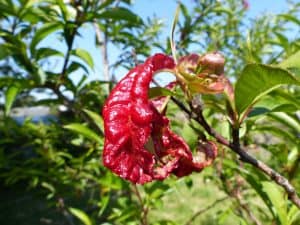 We all like to see beautiful and colorful fruits and these spots have a totally different effect.
We all like to see beautiful and colorful fruits and these spots have a totally different effect.
It affects peach trees and also other fruit trees with similar conditions, such as the almond tree /pests-and-diseases/»>the almond tree.
To recognize the disease, it is necessary to pay close attention to the moments when there are changes in the structure.
The first thing that usually appears is white or light green spots on the leaves, as if it were discoloring.
This progresses until it turns yellow and even rots part of the leaf, which will fall later.
In the case of the fruits, the spots are usually dark and appear superficially to sink inwards later.
Treatment for spots on the peach tree
In this case, the work must be preventive action with the correct application of fungicides. Treatments with sulfur or copper products are also usually effective.
Another important detail is that the bacteria are usually easily dispersed by wind and water.
For this reason, the use of irrigation systems that produce water wells should be avoided.
Taking care of the peach tree from its sowing phase is key to achieving the best results during its growth and flowering time.
Above all , care should be increased between spring and summer, which is when bacteria and fungi tend to grow faster.
From the rest, all that remains is to enjoy the juiciness and flavor of a well-harvested fruit.
peach leprosy
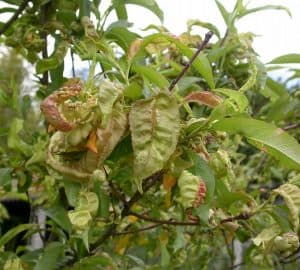 To learn more, see this article: Peach tree leprosy
To learn more, see this article: Peach tree leprosy
It is a disease that consists of a fungus (fungal infection) that appears in peach plantations.
It is easy to recognize by the appearance of wrinkled, reddish leaves on the spring shoots. We will be able to observe bulges (dents).
Therefore, peach tree leprosy is also called «Dent». While its scientific name is » Taphira deformans «.
After approximately 45 days from the start of the outbreak, the diseased leaves fall off the tree.
Due to the above, the tree tends to weaken, bearing fruit poorly. If leprosy is not treated correctly, such a tree can die.
Peach leprosy is considered a serious disease for these fruit trees.
bacterial chancre
Bacterial canker is an infection that causes cracked bark and weeping cankers on the stems, branches, and trunks of affected peach trees.
Bacterial canker is a serious disease that can kill your peach tree, especially if the lesions appear on the lower trunk and cause narrowing.
The bacteria destroy or block the phloem, which transports water and nutrients to all parts of the peach tree. The bacterium does not affect the roots of the peach tree.
- Symptoms: Long oozing cankers form around the bases of shoots and on the trunk and branches of affected peach trees. The dark, recessed areas of dead plant material have long streaks that extend into healthy tissue. Affected areas can die, including the peach tree itself. Diseased tissue under the bark has a characteristic sour odor. Bacterial canker appears as small brown-red dots on the fruit and causes deformities and cracks in the flesh.
- Treatment: When bacterial canker causes peach leaves to drop early, apply high-concentration sprays of copper -containing fungicides. Prune damaged stems and twigs a few inches behind the canker. For cankers on or near the trunk, seek professional help. Prevent the spread of bacteria by working only on dry bark and by keeping tools sterilized.
- The cause: The bacterium Pseudomonas syringae.
- Risk factors: Peach trees planted in deep, sandy soils or in areas with nematodes have a higher risk of infection. Extended periods of hot, humid weather also increase susceptibility. Avoid applying high- nitrogen fertilizers from mid-June through September. Do not encourage late growth in fall . Young, stressed peach trees are especially vulnerable, especially if they have frost damage or sunburn.
- Season: Spring and summer.
- Threat Level: High; can cause the death of your peach tree.
Advertisements
bacterial stain
Bacterial spot can be mild or so severe that the entire peach season is lost. This pathogen affects leaves, twigs and fruits. Severe leaf loss will impair fruit development and make shoots and wood less able to withstand winter weather. Your peaches may also get sunburned or cracked due to bacterial spot.
- Symptoms: Tiny purple, black or brown lesions appear on the tips of the leaves and then migrate to the center of the leaves. The affected areas die and leave holes. Heavily infected leaves turn yellow and fall off the peach tree. On peaches, bacterial spot appears as small, circular, olive-colored spots that become darker and more depressed as the bacteria take hold. The spots can develop cracks, leaving the peaches exposed to rot.
- Treatment: Bacterial spot overwinters in cracks in the bark, near buds, and in leaf scars. Dormant sprays are essential in the fall to protect the stems of your peach tree. Use a copper-based fungicide on the leaves of your peach tree when they begin to drop.
- Cause: The bacterium Xanthomonas arboricola pv. pruni (formerly Xanthomonas campestris pv. pruni)
- Risk Factors: Peach trees are at increased risk of bacterial spot when planted in nutrient-poor or light, sandy soils and in areas with nematode infestations. Humid conditions, above 65 degrees, make it easy for bacteria to infect newly emerged leaves or enter through wounds in the bark.
- Season: Infections occur throughout the growing season, but bacteria begin to spread in late winter.
- Threat Level: Low to High. Bacterial spot can ruin peach crops and is difficult for home gardeners to manage.
brown rot
Brown rot, one of the most common diseases of the peach tree, is a serious fungal infection that affects the fruit, flowers and shoots. Contamination spreads rapidly and must be dealt with proactively.
- Symptoms: Brown rot spores infect peach blossoms in spring, spreading to buds and fruit. Flowers wilt, gummy cankers form on branches, and peaches that develop brown spots quickly rot. Affected fruits turn into mummy covered with spores.
- Treatment: Remove infected fruit mummies from trees and also those that have fallen to the ground. Prune the peach tree in winter to eliminate areas with cankers and ensure proper air circulation. Use fungicides with propiconazole or captan (make sure they are safe for peach trees). Start spraying at full bloom and repeat twice at 10-14 day intervals. Once the peaches start to change color, start spraying every seven days.
- Cause: The fungus Monilinia fructicola.
- Risk factors: Humid and wet environment, and overgrown trees. Leftover fruit mummies, dead flowers, and cankers will re-infect trees during the growing season. The pathogen will survive the winter.
- Season: Brown rot begins in the spring bloom and can cause many infections throughout the year.
- Threat Level: Serious if not promptly intervened.
Brown rot can destroy your peach crop and its treatment is very laborious. Diseased fruits, flowers and shoots are vectors for reinfection and must be disposed of safely.
crown gall
Crown gall is widespread and affects many plants, including peach trees. Although it probably won’t kill your peach tree, it can cause stunted growth and problems with fruit production.
- Symptoms: Irregularly shaped tumors grow on the roots, crown, and sometimes branches, trunks, and stems. The lumps start out small and soft, hardening to a woody texture. Peach trees grow slowly and are stunted; the leaves may be smaller than expected and the tree may not bear fruit. Galls can impede the circulation of water and nutrients.
- Treatment: Soak peach seedlings in an antibacterial wash before planting. Prevention is key, so avoid damaging trees and practice proper pest control to keep boring insects at bay.
- Causes: The bacterium Agrobacterium tumefaciens.
- Risk factors: Moderate; it can contribute to general ill health or death. It makes the peach tree more vulnerable to wind damage and drought. May kill young peach trees if galls are large or numerous. The crown gall likes warm, moist conditions.
- Season: Crown gall can infect peach trees at any time.
- Threat Level: Low.
peach leaf curl
By the time you see the symptoms of peach leaf curl, it will be too late to treat your tree.
Like all fungal diseases, peach leaf curl thrives in warm, humid conditions.
- Symptoms: Look for thickened haojas that curl and pucker. Peach leaf curl can also infect fruit and shoots. Swellings appear on the tops of young peach leaves, and the affected area turns red. The leaves turn yellow and fall to the ground. Affected peaches have small white spots that rot.
- Treatment: Prevention is the most important tool against peach leaf curl. As soon as temperatures reach 25ºC, the fungus begins to reproduce and release spores. Before this happens, treat your peach trees with a spray containing copper. The best times to spray are in the fall, after the leaves have fallen, and in early spring, before the buds open.
- The cause: The fungus Taphrina deformans.
- Risk factors: Hot and humid weather.
- Season: Spring.
- Threat Level: Moderate; peach leaf curl stunts the growth of affected branches and shoots and makes them more vulnerable to frost. Peach leaf curl damages the fruit.
peach scab
This fungal disease can affect a small number of your peaches or completely destroy your season. Infection occurs in spring, but symptoms do not manifest until much later.
- Symptoms: Raised spots affect fruit, leaves and shoots.
- Treatment: By the time peach scab spots appear, it is already too late to treat them. Proactively spray your peach tree about two weeks after blossom drop. Use a sulfur fungicide. Spray three times, with an interval of seven to ten days between applications.
- The cause: The fungus Cladosporium carpophilum.
- Risk factors: Your peaches may be smaller than expected and more susceptible to other diseases.
- Season: Spring.
- Threat Level: Low to moderate; In severe cases, your peach crop will be lost to secondary infection, cracking, or rot.
fungal rust
Are your peach tree leaves falling off prematurely?
If they are dotted with little yellow dead spots, you probably have a fungal rust outbreak.
- Symptoms: Bright and angular yellow spots on the leaves that end up causing their premature fall. Look for rust-colored spore masses. Rust can also affect fruit. Rust produces cankers with rust-brown, powdery spores.
- Treatment: Apply sulfur -based fungicidesor sterol inhibitors in spring.
- Cause: The fungus Tranzschelia discolor.
- Risk factors: Hot and humid weather.
- Season: Summer and Autumn.
- Threat Level: Low; rust can contribute to secondary infections on your peaches.
gummosis
This disease can kill branches or trees and is caused by the fungus Botryosphaeria dothidea.
The first symptoms appear on the young bark of vigorous trees in the form of small blisters, which usually appear on the lenticels.
Infection occurs late in the season and may be evident in the fall or the following spring.
Some infected areas exude a gummy resin. Two- or three-year-old trees often have sunken diseased areas (cankers) on the trunk and main branches.
Large amounts of gummy exudate, or rubber balls, are associated with multiple site injuries. After repeated infections, the bark becomes rough and scaly.
Prevention and treatment: There is no practical chemical control. Keep the trees healthy, as the most infected trees suffer from water stress.
Dead wood must be removed during winter pruning and destroyed.
When pruning during the summer months, remove and destroy all pruned wood.
When gummosis is present, the preferred treatment is the use of myclobutanil for scabies control.
anthracnose
Also «bitter rot » of the peach.
Anthracnose is an infection that affects many species of fruit trees, including peaches. Most of the damage is cosmetic, but it still needs to be controlled. Rain and irrigation systems can spread the disease, which tends to occur in hot, humid weather.
Symptoms: Peach anthracnose usually appears on ripe or nearly ripe fruit. Small brown or tan lesions, which enlarge and darken, gradually become circular and slightly indented.
In the early stages, these lesions may be confused with brown, black, or white rot, but anthracnose spots are firmer and larger, and are often accompanied by rings of pink spore masses.
Leaves and twigs are not affected. Anthracnose does not kill the tree, but damages the fruit/yield.
Pests that attack the peach tree
aphids
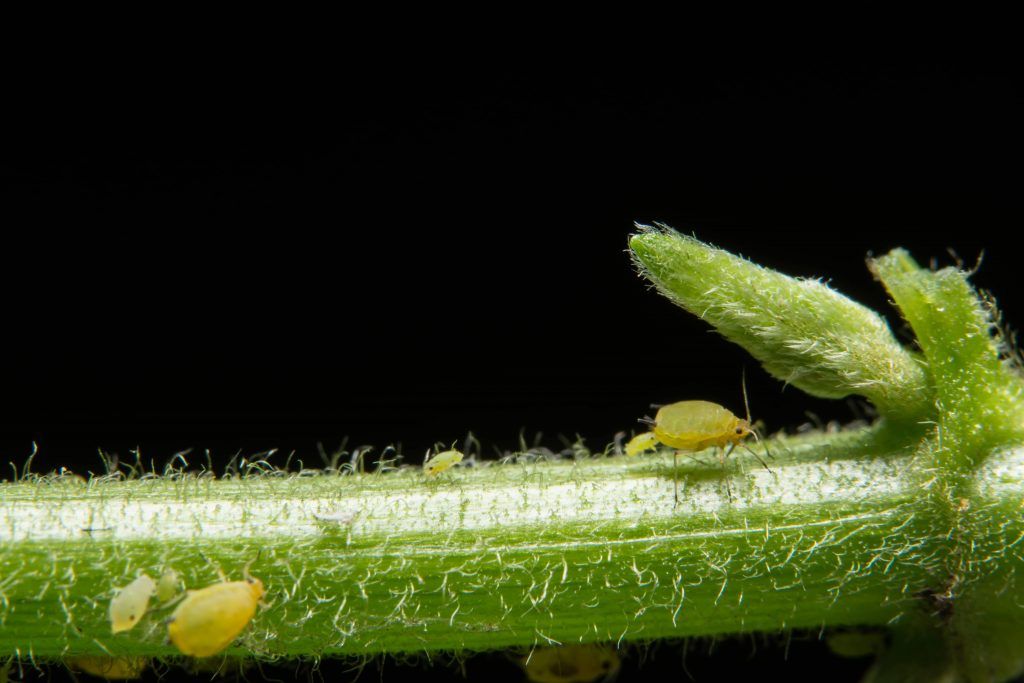
Tiny insects, about the size of a pinhead, whose color varies depending on the type. They cluster on the stems and under the leaves, sucking the juices from the plants.
Symptoms: Leaves curl, thicken, turn yellow and die. Aphids produce large amounts of a sticky residue called honeydew that attracts insects such as ants.
Molasses also becomes a growth medium for sooty mold.
Control: Spray. It also works, with ahigh pressure hose, to spray the leaves.
Lygus bugs and stink bugs
Lygus bugs are small oval insects that are brown, green, gray, or almost black in color with a yellow «V» on their back. Stink bugs are usually gray or brown, shield-shaped, and about ½ inch long.
Symptoms: Bugs damage fruit and flowers. The stink bug bores into the fruit and sucks out the juice, causing sunken spots on young fruit or deformation of mature fruit (cat face).
Both can be avoided by planting peach trees away from hayfields, which are often hosts.
oriental fruit moth
Pests and damage are similar to those of the cod moth.
Adults are small grayish moths. Larvae are pinkish-white with a reddish-brown head. Pheromone traps are one option to attract moths.
Symptoms: The damage appears first in the vegetative growth, and if left untreated it ends up infesting the fruit. The larvae tunnel through the stem and usually hatch near the bone.
Control: Spray.
borer
Includes: American plum borer, Pacific flathead borer, peach twig borer, peach tree borer, shot hole borer
These pests burrow and feed under the bark on the sapwood, weakening the tree and causing its death.
Borers can target the graft site (on young peach trees) to lay their eggs, as well as damaged or sunken areas, and even a few inches below the soil line.
The worms have a cream colored body. Difficult to control once infested; preventive action is the best defense.
Symptoms: A thick, gummy substance (sap) that drips from round holes in the trunk or crotch of the tree. The worms tunnel through the trunks, weakening and eventually killing the tree.
The eggs hatch and the larvae tunnel into the vascular tissue of the tree.
autumn caterpillar
This species is similar to the eastern tent caterpillar, but builds its web over the end of the branch, rather than in the crotch of the tree.
It feeds on almost all trees except conifers. The webworm caterpillar is about two centimeters long, with a black to reddish head and light yellow to greenish body with a mottled stripe of two rows of black tubercles and tufts of long whitish hairs.
Adults appear as white moths with dark spots on their wings.
Symptoms: The ends of the branches are wrapped in a large spider web in which the larvae feed, skeletonizing the leaves.
Control: Manual.
Remove the fabrics with a rake (the caterpillars are removed with the fabrics) and burn.
sheet roller
Small caterpillars about two centimeters long, in colors ranging from pale yellow or green to brown. Leafrollers usually have dark heads.
Symptoms: Leaves and flowers curl and intertwine where the larvae feed. The foliage ends up being skeletal. Leafrollers do not penetrate the fruit, but can leave scars on the fruit.
Control: Manual. Manual removal of tangled foliage and keeping the area free of weeds and debris may be sufficient to control the pest.
nematodes
Includes: root knot nematodes, ring nematodes, lesion nematodes, dagger nematodes.
Nematodes (microscopic worms) live in the soil and in plant tissues, and can do a lot of damage to peach trees. Have your county extension agent test the soil before planting to determine the extent of their presence.
Symptoms: The nematodes perforate the tissue cells and feed on them, normally damaging the roots. Tree growth is stunted and leaves may show signs of yellowing ( chlorosis). Sandy soils are more susceptible.
Control: Preventive.
Fumigar antes de la plantación (en otoño, cuando la temperatura aún es de unos 55 grados), o alternar cultivos de cobertura no aptos para nematodos. La mejor prevención es comprar melocotoneros con portainjertos resistentes a los nematodos.
Otros posibles problemas de los melocotoneros
¿Qué es el polvo blanco que aparece en las hojas de mi árbol?
Se trata de la enfermedad del oídio. Una infección importante puede reducir el vigor del árbol.
Pregunta: Las hojas de mi árbol han desarrollado manchas negras y verdosas y se caen antes de tiempo. ¿Qué ocurre?
Su árbol está afectado por la enfermedad de la sarna del melocotonero. Esta enfermedad también puede atacar a los frutos (véase más abajo).
¿Por qué las hojas de una rama de mi melocotonero se han vuelto de color plateado?
The most likely cause is a disease called silver leaf, which can also cause branch dieback.
The leaves of the young shoots of my peach tree are curled and sticky. What is the cause?
The shoots are infested with aphids.
There are several species that can affect peach trees; some species leave the tree in summer to search for other host plants, while others remain on the tree. The sticky substance produced by aphids is honeydew, which can lead to the appearance of fungi.
The rare rosy peach aphid causes leaves to become misshapen and red.
The rosy peach aphid is a common pest and causes curly, yellowish-green leaves; it can also affect fruit (see below).
What eats the leaves of my peach tree?
The caterpillars of various species of moths eat the leaves of peach trees.
- Winter moth caterpillars are especially troublesome between bud and late May, as they also eat flowers and damage young fruit.

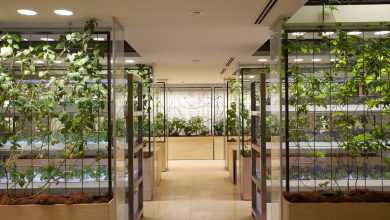
![Photo of Onion Diseases: [Characteristics, Types, Detection and Treatment]](https://www.complete-gardening.com/wp-content/uploads/2022/08/onion-diseases-characteristics-types-detection-and-treatment-390x220.jpg)
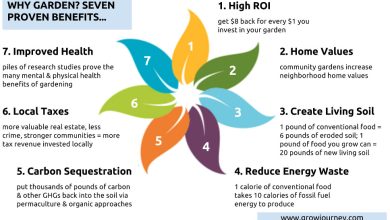
![Photo of Bougainvillea Cuttings in Water: [Concept, Time, Rooting and Planting]](https://www.complete-gardening.com/wp-content/uploads/2022/08/bougainvillea-cuttings-in-water-concept-time-rooting-and-planting-390x220.jpg)